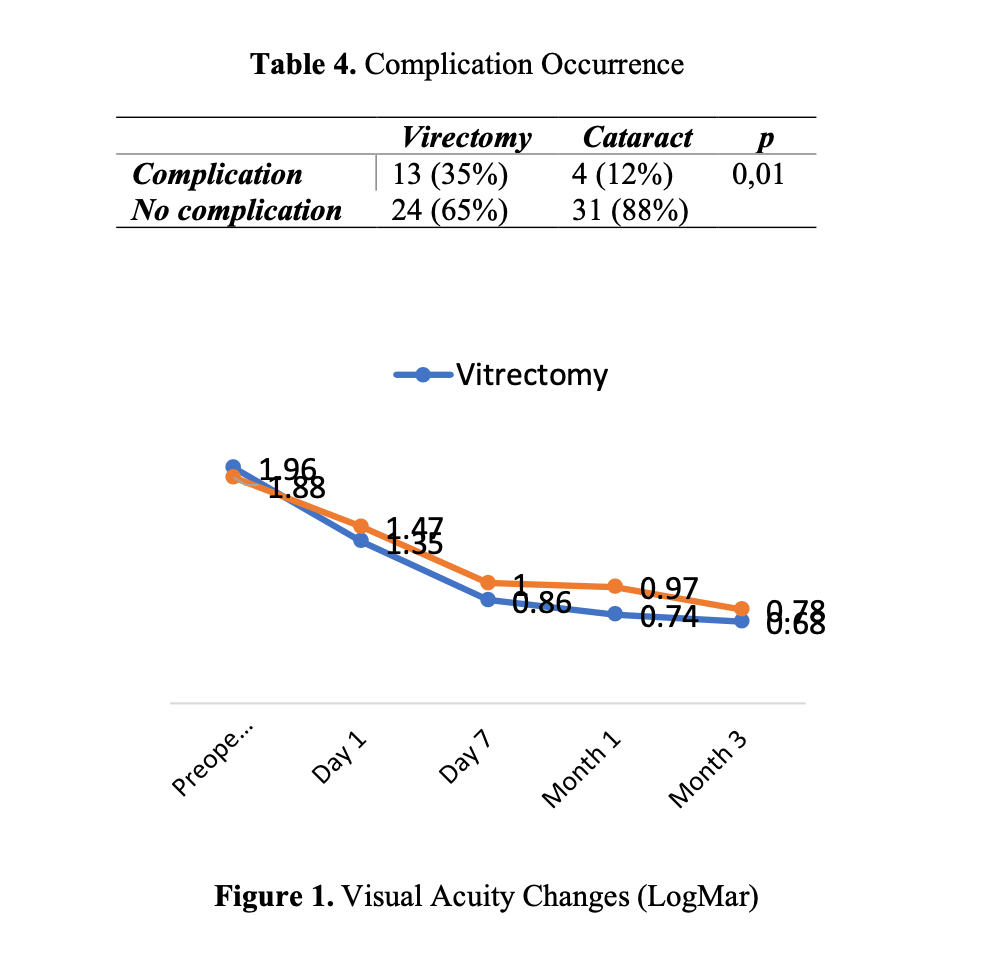SECONDARY GLAUCOMA AFTER VITREORETINAL SURGERY: A RETROSPECTIVE OBSERVASIONAL STUDY Oral Presentation - Observational Study - Resident
Abstract
Introduction & Objectives
Secondary glaucoma is the most common complication after vitreoretinal surgery. Pars Plana
Vitrectomy (PPV) is a common surgical procedure aimed at removing vitreous gel and replacing it
with variety of substances denominated tamponades. Vitreous removal and replacement may cause
increased intraocular pressure (IOP). The IOP can be reduced with medical treatment or surgery.
The purpose of this study is to describe the characteristics of secondary glaucoma after vitreoretinal
surgery in National Eye Center Cicendo Hospital from January 2019 - December 2020.
Methods
This study was a retrospective descriptive study which data were obtained from medical records.
Data such as age, gender, vitrectomy tamponades, IOP, onset of glaucoma, and glaucoma treatment
were collected.
Results
One hundred fifty-three eyes were referred to Glaucoma Unit with increasing IOP after vitreoretinal
surgery. PPV with tamponade was done in 141 eyes (92.16%) and silicone oil (SO) 1000 centistokes
(cSt) was the most used tamponade in 101 eyes (66.07%). Secondary glaucoma with open angle was
the most common type in 124 eyes (81.04%). Secondary glaucoma developed in 4-7 weeks after
surgery, with the highest IOP recorded at 31-40 mmHg. The IOP decreased after SO evacuation with
initial glaucoma treatment in 121 eyes (79.09%), and glaucoma surgery was performed in 32 eyes
(20.91%).
Conclusion
Silicon oil as a tamponade agent after PPV may cause rise IOP in the post-operative period.
Evacuation SO needs to be done after retinal adhesion to prevent secondary glaucoma. Therefore,
timely detection and anti-glaucoma treatment are important to decreased IOP, or filtration surgery
can be performed.
Full text article
References
World Health Organization. World repost on vision. 2019. https://apps.who.int/iris/bitstream /handle/10665/328721/WHONMH-NVI-19.12-eng.pdf
Idrus EA, Gandasubrata AP, Iskandar E. Characteristics of secondary glaucoma post vitreoretinal surgery at national eye center cicendo eye hospital from January 2010 to December 2011. Bali J Ophthalmol. 2017;1(1):1-5.
Tanna AP, Boland MV, Giaconi JA. Glaucoma. Dalam: Basic and Clinical Science Course. San Fransisco: American Academy of Ophthalmology: 2021. hlm.14851
McCannel C, Berrocal A, Holder G. Other Retinal Vascular Disease. In: Basic and Clinical Science Course: Retina and Vitreous. San Fransisco: American Academy of Ophthalmology; 2021. hlm. 38190.
Triwijayanti T, Djatikusumo A, Victor AA, et al. The Evaluation of Silicon Oil Evacuation Procedure In Cipto Mangunkusumo Hospital Indonesia. International Journal of Retina. 2019;2(1)8:1-5.
Karaca U, Kucukevcilioglu M, Durukan AH, et al. The effect of longstanding silicone oil on retina choroid and optic nerve in eyes with retinal detachment: an optical coherence tomography study. BMC ophthalmology. 2022;22(1):1-7.
Mansukhani SA, Barkmeier AJ, Bakri SJ, et al. The risk of primary open-angle glaucoma following vitreoretinal surgery—a population-based study. American journal of ophthalmology. 2018;193:143-55.
Rossi T, Ripandelli G. Pars Plana Vitrectomy and the Risk of Ocular Hypertension and Glaucoma: Where Are We?. Journal of Clinical Medicine. 2020;9(12):3994.
Tawfik AAM, Abdallah NH, Elewa LS, et al. Influence of Silicone Oil Tamponade after Vitrectomy on Intraocular Pressure. The Medical Journal of Cairo University. 2019;87(7):4691-7.
Vaziri K, Schwartz SG, Kishor KS, et al. Tamponade in the surgical management of retinal detachment. Clinical Ophthalmology (Auckland, NZ). 2016;10:471.
Nicolai M, Lassandro N, Franceschi A, et al. Intraocular pressure rise linked to silicone oil in retinal surgery: a review. Vision. 2020;4(3):36.
Yu J, Zong Y, Jiang C, et al. Silicone oil emulsification after vitrectomy for rhegmatogenous retinal detachment. Journal of ophthalmology. 2020.
Fang Y, Long Q, Wang X, et al. Intraocular pressure 1 year after vitrectomy in eyes without a history of glaucoma or ocular hypertension. Clinical Ophthalmol. 2017;11:2091–7. ?
Jo J, Sung KR, Kim YJ. Influence of vitrectomy-related factors on the outcome of Ahmed glaucoma valve implantation. Korean Journal of Ophthalmology. 2018;32(5):400-8.
Authors
Copyright (c) 2023 Liani Mulasari Gunawan, R. Maula Rifada, Elsa Gustianty, Sonie Umbara

This work is licensed under a Creative Commons Attribution-NonCommercial-ShareAlike 4.0 International License.


